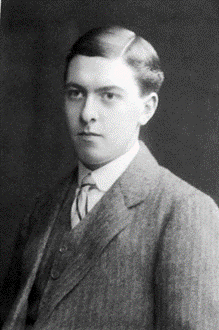Fact file:
Matriculated: 1908
Born: 22 August 1889
Died: 15 August 1915
Regiment: Royal Garrison Artillery
Grave/Memorial: Wimborne Minster Cemetery, Dorset: C.9.4821
Family background
b. 22 August 1889 as the only son (two sisters) of Revd Ernest Dewes (D’Ewes) Bradshaw Benison (1858–1933) and Jessie (neé Kemp-Welch) (1854–1942) (m. 1886). In 1891 the family lived in Pokesdown Vicarage, near Christchurch, Hampshire (four servants), in 1901 they lived at Spindley, Wimborne Road, Bournemouth (five servants) and in 1911 at Farrs, Wimborne, Dorset (four servants).
Parents and antecedents
Although he was born in Balsall Heath, Worcestershire, Benison’s father came from an Irish family and was educated at Trinity College Dublin (BA 1883, MA 1887). He was ordained deacon and priest in Tuam Cathedral. He held various curacies, including being curate to his father, who was Vicar of Balsall Heath (1889–95), until he was appointed Vicar of Pokesdown, Hampshire (1889–95). According to the Hartlepool Northern Daily Mail he resigned the living at Pokesdown under unusual circumstances. Pokesdown was a poor parish with a large proportion of the working class of Bournemouth and the endowment was a mere £34 p.a., but when he took up the position there was “a sort of half understanding” that the Ecclesiastical Commissioners would make a further grant proportionate to the population after the 1891 Census. This the Commissioners did not do and there was “general regret that his means will not permit him to continue”. This perhaps did not go down well, as for the next 25 years he held no post, but was given permission to officiate at St Augustine’s in Bournemouth and in the Diocese of Salisbury. In 1922 he was appointed Perpetual Curate of St Stephen’s, Kingston Lacy, Wimborne. At the time of the 1901 census he was “living on own means” and in 1911 was simply “Clergyman of Established Church”.
Benison’s grandfather William Bradshaw Benison (born c.1821 in India or Ireland [different birth place in successive Censuses], died 1906) also graduated from Trinity College Dublin and was Vicar of St Paul’s, Balsall Heath (1853–86) and Rector of Uley-with-Owlpen, Gloucestershire, from 1886 until his death in 1906.
Benison’s mother was the daughter of John Kemp-Welch (1810–85) a wealthy merchant and JP living at Clock House, Clapham Common, London, at the time of the 1871 Census, but who originally came from Southsea, Hampshire. In 1834, when a wine merchant in Bath, he and William Evill (1790–1877) (a silversmith) bought a carbonated drinks company from Jacob Schweppes (1740–1821). The two partners developed and ran Schweppes as a successful family company until their deaths, when it passed to their descendants, who converted it into a limited liability company in 1886.
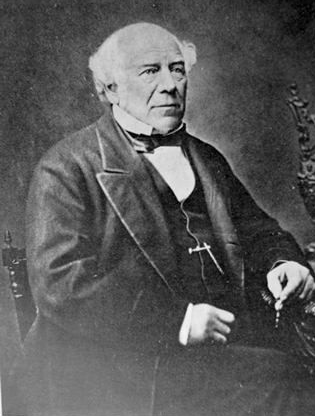
John Kemp-Welch (1810–85)
Siblings and their families
Brother of:
(1) Aileen Mary Dewes Benison (1890–1974), who was unmarried and seems to have lived her whole life in Kings Lacy. She was honorary secretary of the Subscribers to the Victoria Cottage Hospital, Wimborne.
(2) Marjorie Benison (1892–1964); unmarried and lived with her sister in Kings Lacy.
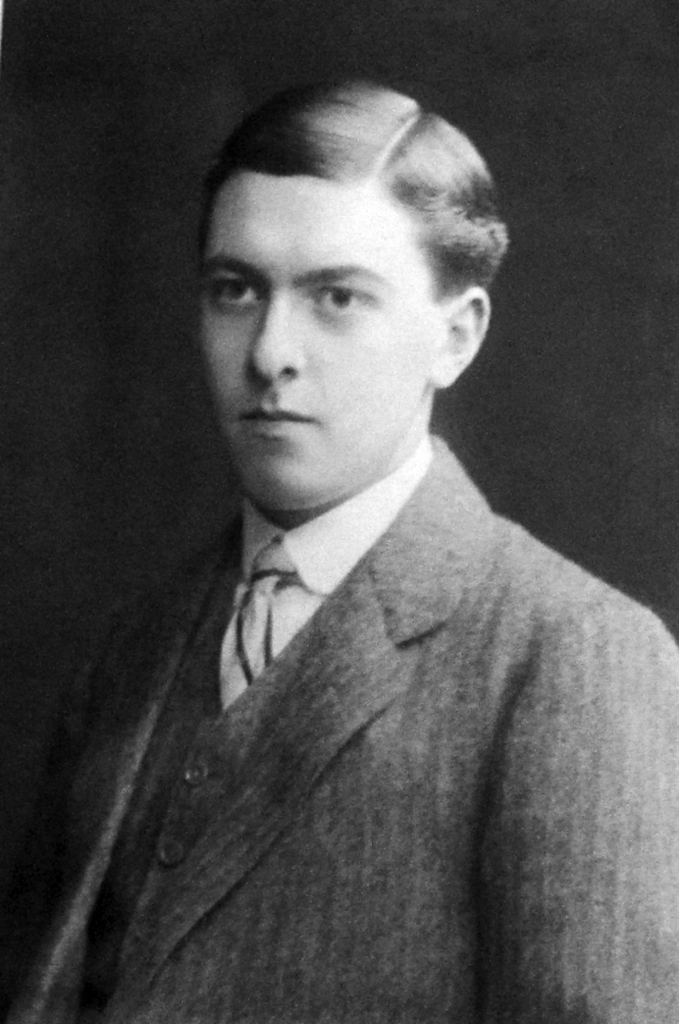
Eric William Benison
(Photo courtesy of Magdalen College, Oxford)
“Eric Benison was well known up here, and deservedly popular both in his College
and in the University. […] He had considerable gift and insight for politics, and might
have gone some way in public life.”
Education and professional life
Benison attended Cheam Preparatory School, near Epsom, Surrey, from c.1889 to 1903 (cf. J.R. Platt, L.S.P. Platt, G.T.L. Ellwood, A.G. Kirby, A.F.C. Maclachlan, R.N.M. Bailey, C.P. Rowley). Founded in c.1645 by the Revd George Aldrich (1574–1658), it moved to nearby Tabor House in 1719, where it stayed until 1934 when it moved to its present site at Headley, Hampshire. It was sometimes known as Manor HJ.R. Plattouse Preparatory School because that, according to the Censuses, was the proper name of its buildings, and sometimes, from 1856, as Mr R.S. Tabor’s Preparatory School, when the Revd Robert Stammers Tabor (1819–1900) became its Headmaster (until 1890) and set about turning it into a purely preparatory school and, arguably, the top preparatory school in the country. Benison then attended Sherborne School from 1903 to 1908, where he became a Prefect. In 1905 the school put on a pageant in celebration of the twelve hundredth anniversary of the founding of Sherborne. Benison played a part in Episode 10, ‘The School Receives its Charter’.
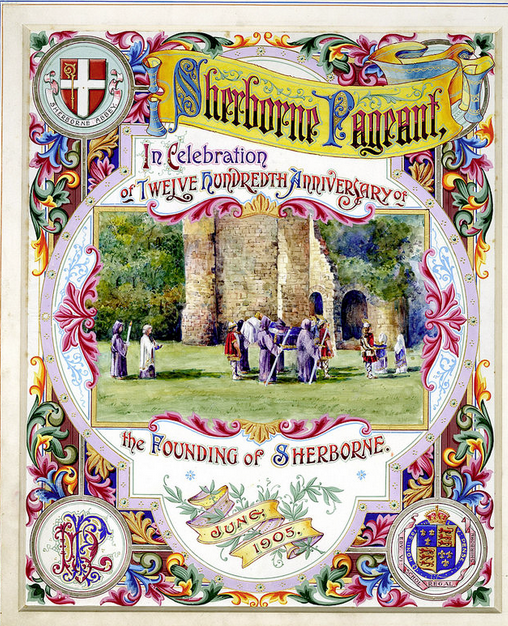
Sherborne Pageant, staged at Sherborne Old Castle 12–16 June 1905
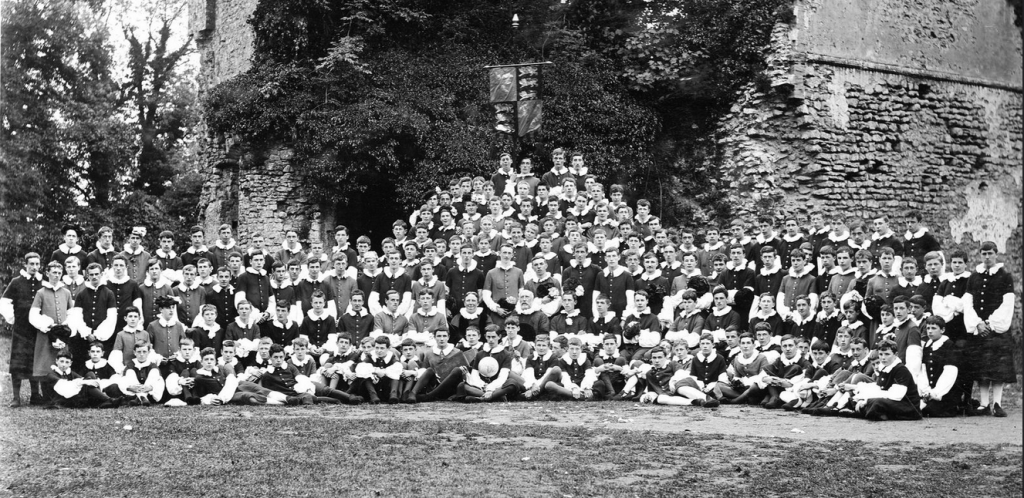
Performers in Episode 10 of Sherborne Pageant; Benison was one of these
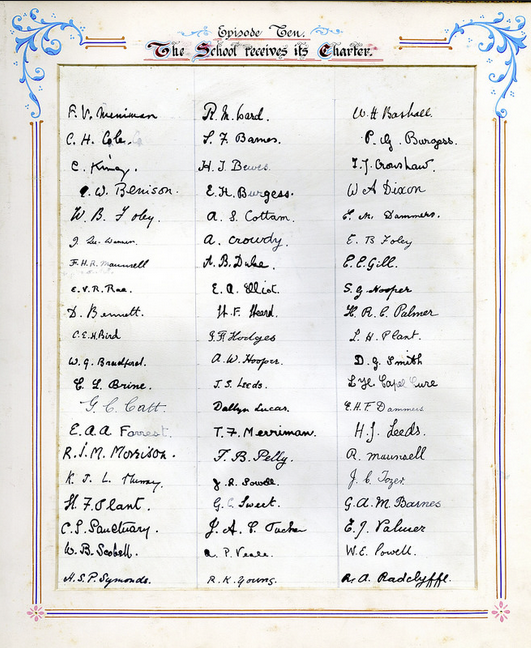
Performers in Episode 10 of Sherborne Pageant; note Benison’s signature four down in the left-hand column
(With thanks to Sherborne School Archives)
Benison matriculated at Magdalen as a Commoner on 14 October 1908, having been exempted from Responsions because he possessed an Oxford and Cambridge Certificate. Right from the start of his time at Magdalen, his tutors thought very little of him: “Weak will get a 3rd”, “Virtuous – not very strong”, “No good at Classics – intelligent – interested in too many things”, “Will get a 3rd”, “May get a 3rd […] – satisfied if he gets through”. He took the First Public Examination in the Trinity Terms of 1909 and 1910, but failed Divinity first time round (March 1909) and the rest of Moderations the second time round (March 1910), whereupon he changed to a Pass Degree course in order to pass Moderations. He then changed to the Honours course in Modern History and was awarded a 3rd in that subject in Trinity Term 1912; he took his BA on 9 November 1912. During his time at Oxford, he played a lot of golf, but was particularly active in the student political world: he was Vice-Secretary of the Canning Club; he was one of the founders, if not the originator, of the New Tory Club, and its first Secretary and Honorary Treasurer; and he was active in the Oxford University Tariff Reform League (see N.G. Chamberlain), and at the time of the 1910 General Election he toured the country with other Oxford undergraduates speaking on Tariff Reform. He joined the Middle Temple in 1909 and took Bar Finals (Class II) in 1915. It was unusual for a non-sportsman to be chosen as one of Isis’s “Idols”, and his eulogist, with considerably less levity than sometimes accompanied the eulogy, wrote: “It is difficult fully to appreciate how much [the New Tory Club] owes to his extraordinary energy and business capacity. He not only has ideas, but the power to realize them. […] we seem to see, dimly outlined there, the figure of an able and successful barrister.” President Warren confirmed this judgement posthumously when he wrote: “Eric Benison was well known up here, and deservedly popular both in his College and in the University. […] he had considerable gift and insight for politics, and might have gone some way in public life. A valuable man, and a good influence, he would certainly have been, had he done so, in the world, as here.” In 1909 Benison addressed the Wimborne Conservative Club on the Principles of Tariff Reform and was thought to have “acquired an excellent style of oratory”.
Benison was also a member of the Hanover Club, which was inaugurated on 2 May 1911 to foster good relations between England and Germany and to give University students the opportunity of meeting one another and discussing issues of importance to both countries. The first full meeting took place on 9 May with 22 members, and Benison, along with Eugen Millington Drake (1889–1972) and Ivan Tattersall Hodgkinson (1891–1931), was one of the three Magdalen members. According to the minutes, Benison “Confessed that till that night he had never known any German except a governess (cries of shame). England was indebted to Germany for schemes of Social reform.”

From the Minute Book of the Hanover Society held in the Archives of Balliol College
At the third meeting of the club on 13 June it was announced that the committee had elected Benison President for Michaelmas Term. Benison expressed his thanks and “passed a vote of thanks on the parting President Count (Albrecht von) Bernsdorff” (1891–1945) (later a member of the Solf circle involved in resistance to Nazi Germany, and murdered in KZ Ravensbrück). In the first meeting of Michaelmas term Benison as President addressed the club briefly, once more stating its aims. As well as Benison, the six members of the selection committee included Walter Turner Monkton (1891–1965) (adviser to Edward VIII during the abdication crisis and Conservative cabinet minister) and Kurt Matthias Robert Martin Hahn (1886–1974) (educationist and founder of many schools including Gordonstoun). Although President, Benison was not among the more active members contributing to the minuted discussions, though at the meeting on 3 November in Kurt Hahn’s rooms he “very rightly saw the danger of conservative parties in both countries losing touch with the lower classes”. At a meeting of the committee held on 5 December “Mr Monkton was elected President for the coming term, Mr. Benison being too busy to continue in office”. He did however continue to serve on the selection committee. This was his last mention in the minutes of the club.
The extant minutes list the names of 50 members – 21 German and 29 British, including Robert McGowan Barrington Ward (1891–1948) (editor of The Times 1941–48) and Maurice Harold MacMillan (1894–1986) (prime minister). Four of the Germans and eight of the British members of the club were killed in the war.
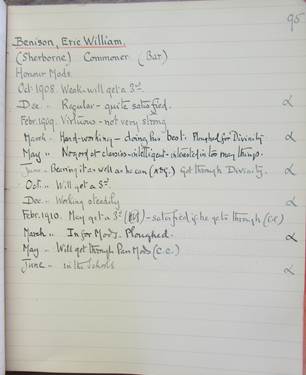
Benison’s academic record (1908–10), compiled by H.W. Greene et al., Magdalen College Archives: F29/1/MS5/5 (Notebook containing comments by H.W. Greene et al. on student progress [1895–1911]), p. 95
On 4 November 1909 he was admitted to the Middle Temple. Despite the reservations of his Magdalen tutors, he came equal eighth out of the 83 taking the Bar Finals in April 1915. He was not called to the bar before he joined the army.
War service
Benison was gazetted Second Lieutenant, 3 Company, Royal Garrison Artillery Territorial Force (Dorsetshire) on 18 March 1915. He was on duty at Breakwater Fort, Weymouth, on the morning of 10 August 1915, when he suddenly fell ill. He underwent an operation on 11 August and died of peritonitis, aged 26, on 13 August 1915 in a nursing home at Weymouth. On 17 August 1915 he was buried in the Cemetery of Wimborne Minster, Dorset, Grave C.9.4821. He is commemorated in the Ante-Chapel, Sherborne School. He left £17 16s 2d.

Benison’s grave (C.9.4821) in the Cemetery of Wimborne Minster, Dorset

The record of his effects showing that his father took responsibility for any outstanding claims or debts
Bibliography
For the books and archives referred to here in short form, refer to the Slow Dusk Bibliography and Archival Sources.
Printed sources
[Anon.], ‘Society Small Talk by Upper-Crust Gossipers’, Hartlepool Northern Daily Mail, no. 4331 (23 April 1892), p. 7.
R.M.B.W, ‘Isis Idol, No. CCCCLIII: Mr Eric William Benison’, The Isis (Oxford), no. 477 (24 February 1912), pp. 223–4.
Council of Legal Education, ‘Easter Examination Results’, The Times, no. 40828 (14 April 1915), p. 4.
[Thomas Herbert Warren], ‘Oxford’s Sacrifice’ [obituary], The Oxford Magazine, 34, extra number (5 November 1915), p. 17.
Edward Peel, Cheam School from 1645 (Gloucester: The Thornhill Press, 1974), passim.
Leinster-Mackay (1984), pp. 29, 40–2, 107, 114, 135.
Karsten Plöger, ‘The Hanover Club, Oxford (1911–13): Student Paradiplomacy and the Coming of the Great War’, German History, 27, no. 2 (April 2009), pp. 196–214.
Archival sources:
MCA: F29/1/MS5/5 (Notebook containing comments by H.W. Greene et al. on student progress [1895–1911]), p. 95.
MCA: PR32/C/3/114 (President Warren’s War-Time Correspondence, Letter relating to E.W. Benison [1915]).
MCA: Ms. 876 (III), vol. 2.
OUA: UR 2/1/65.
